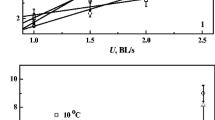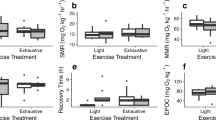Abstract
The effects of acclimation temperature (15, 20, 25 °C) on routine oxygen consumption and post-exercise maximal oxygen consumption rates (MO2) were measured in juvenile shortnose sturgeon (Acipenser brevirostrum LeSueur, 1818). The routine MO2 of shortnose sturgeon increased significantly from 126.75 mg O2 h−1 kg−1 at 15 °C to 253.13 mg O2 h−1 kg−1 at 25 °C. The temperature coefficient (Q 10) values of the routine metabolic rates ranged between 1.61 and 2.46, with the largest Q 10 values occurring between 15 and 20 °C. The average post-exercise MO2 of all temperature groups increased to a peak value immediately following the exercise, with levels increasing about 2-fold among all temperature groups. The Q 10 values for post-exercise MO2 ranged from 1.21 to 2.12, with the highest difference occurring between 15 and 20 °C. Post-exercise MO2 values of shortnose sturgeon in different temperature groups all decreased exponentially and statistically returned to pre-exercise (resting) levels by 30 min at 15 and 20 °C and by 60 min at 25 °C. The aerobic metabolic scope (post-exercise maximal MO2-routine MO2) increased to a maximum value ∼156 mg O2 h−1 kg−1 at intermediate experimental temperatures (i.e., 20 °C) and then decreased as the temperature increased to 25 °C. However, this trend was not significant. The results suggest that juvenile shortnose sturgeon show flexibility in their ability to adapt to various temperature environments and in their responses to exhaustive exercise.



Similar content being viewed by others
References
Aboagye DL, Allen PJ (2014) Metabolic and locomotor responses of juvenile paddlefish Polyodon spathula to hypoxia and temperature. Comp Bioch Physiol 169A:51–59
Baker DW, Wood AM, Litvak MK, Kieffer JD (2005) Haematology of juvenile Acipenser oxyrinchus and Acipenser brevirostrum at rest and following forced activity. J Fish Biol 66:208–221
Baker DW, Peake SJ, Kieffer JD (2008) The effect of capture, handling, and tagging on hematological variables in wild adult lake sturgeon. North Am J Fish Manag 28:296–300
Barton BA, Bollig H, Hauskins BL, Jansen CR (2000) Juvenile pallid (Scaphirhynchus albus) and hybrid pallid × shovelnose (S. albus X platorynchus) sturgeons exhibit low physiological responses to acute handling and severe confinement. Comp Biochem Physiol 126A:125–134
Beitinger TJ, Lutterschmidt WI (2011) Measures of thermal tolerance. In: Farrell AP, Stevens ED, Cech JJ, Richards JG (eds) Encyclopedia of fish physiology—from genome to environment. Academic Press, Waltham
Bemis WE, Findeis EK, Grande L (1997) An overview of Acipenseriformes. Env Biol Fish 48:25–71
Beyea MM, Benfey TJ, Kieffer JD (2005) Hematology and stress physiology of juvenile diploid and triploid shortnose sturgeon (Acipenser brevirostrum). Fish Physiol Biochem 31:303–313
Billard R, Lecointre G (2001) Biology and conservation of sturgeon and paddlefish. Rev Fish Biol Fisher 10:355–392
Birstein VJ, Bemis WE (1997) How many species are there within the genus Acipenser? Envir Biol Fish 48:157–163
Brett JR (1971) Energetic responses of salmon temperature. A study of thermal relations in the physiology and freshwater ecology of sockeye salmon (Oncorhynchus nerka). Am Zool 11:99–113
Cai L, Taupier R, Johnson D, Tu Z, Liu G, Huang Y (2013) Swimming capability and swimming behaviour of juvenile Acipenser schrenckii. J Exp Zool 319A:149–155
Cai L, Johnson D, Mandal P, Gan M, Yuan X, Tu Z, Huang Y (2014) Integrating water flow, locomotor performance and respiration of Chinese sturgeon during multiple fatigue-recovery cycles. PLoS One 9:e94345
Cai L, Johnson D, Mandal P, Gan M, Yuan X, Tu Z, Huang Y (2015) Effect of exhaustive exercise on the swimming capability and metabolism of juvenile Siberian sturgeon. Trans Am Fish Soc 144:532–538
Cataldi E, Di Marco P, Mandich A, Cataudella S (1998) Serum parameters of Adriatic sturgeon Acipenser naccarii (Pisces: Acipenseriformes): effects of temperature and stress. Comp Biochem Physiol 121A:351–354
Crocker CE, Cech JJ (1997) Effects of environmental hypoxia on oxygen consumption rate and swimming activity in juvenile white sturgeon, Acipenser transmontanus, in relation to temperature and life intervals. Environ Biol Fish 50:383–389
Deslauriers D, Kieffer JD (2012) The effects of temperature on swimming performance of juvenile shortnose sturgeon (Acipenser brevirostrum). J Appl Ichth 28:176–181
Eliason EJ, Farrell AP (2016) Oxygen uptake in Pacific salmon Oncorhynchus spp.: when ecology and physiology meet. J Fish Biol 88:359–388
Feshalami MY, Amiri F, Nikpey M, Mortazavizadeh MT (2016) Influence of stocking density on growth and physiological responses of Beluga, Huso huso (Brandt, 1869), and Ship sturgeon, Acipenser nudiventris (Lovetsky, 1828), juveniles in a flow-through system. J World Aquacult Soc Doi. doi:10.1111/jwas.12376
Galloway BJ, Kieffer JD (2003) The effects of an acute temperature change on the metabolic recovery from exhaustive exercise in juvenile Atlantic salmon (Salmo salar). Phys Biochem Zool 76:652–662
Kieffer JD (2000) Limits to exhaustive exercise in fish. Comp Biochem Physiol 126A:161–179
Kieffer JD (2010) Perspective-exercise in fish: 50+ years and going strong. Comp Biochem Physiol 156A:163–168
Kieffer JD, Cooke SJ (2009) Physiology and organismal performance of centrarchids. In: Cooke SJ, Philipp DP (eds) Centrarchid fishes: diversity, biology and conservation. Oxford Press, Wiley, pp 207–263
Kieffer JD, Currie S, Tufts BL (1994) Effects of environmental temperature on the metabolic and acid–base responses of rainbow trout to exhaustive exercise. J Exp Biol 194:299–317
Kieffer JD, Wakefield AM, Litvak MK (2001) Juvenile sturgeon exhibit reduced physiological responses to exercise. J Exp Biol 204:4281–4289
Kieffer JD, Penny FM, Papadopoulos V (2014) Temperature has a reduced effect on routine metabolic rates of juvenile shortnose sturgeon (Acipenser brevirostrum). Fish Physiol Biochem 40:551–559
Killen SS, Norin T, Halsey LG (2016) Do method and species lifestyle affect measures of maximum metabolic rate in fishes? J Fish Biol Doi. doi:10.1111/jfb.13195
Lankford SE, Adams TE, Cech JJ (2003) Time of day and water temperature modify the physiological stress response in green sturgeon, Acipenser medirostris. Comp Biochem Physiol 135A:294–302
Lassalle G, Crouzet P, Gessner J, Rochard E (2010) Global warming impacts and conservation responses for the critically endangered European Atlantic sturgeon. Biol Conserv 30:2441–2452
Mayfield RB, Cech JJ (2004) Temperature effects on green sturgeon bioenergetics. Trans Am Fish Soc 133:961–970
McKenzie DJ, Serrini G, Piraccini G, Bronzi P, Bolis CL (1996) Effects of diet on responses to exhaustive exercise in Nile tilapia (Oreochromis nilotica) acclimated to three different temperatures. Comp Biochem Physiol 114A:43–50
McKenzie DJ, Cataldi E, Romano P, Owen SF, Taylor EW, Bronzi P (2001) Effects of acclimation to brackish water on the growth, respiratory metabolism, and swimming performance of young-of-the-year Adriatic sturgeon (Acipenser naccarii). Can J Fish Aquat Sci 58:1104–1112
Milligan CL (1996) Metabolic recovery from exhaustive exercise in rainbow trout. Comp Biochem Physiol 113A:51–60
Norin T, Clark TD (2016) Measurements and relevance of maximum metabolic rate in fishes. J Fish Biol 88:122–151
Pang X, Yuan X-Y, Cao Z-D, Zhang Y-G, Fu S-J (2015) The effect of temperature on repeat performance in juvenile qingbo (Spinibarbus sinensis). Fish Physiol Biochem 41:19–29
Patterson JT, Mims SD, Wright RA (2013) Effects of body mass and temperature on routine metabolism of American paddlefish Polodon spathula. J Fish Biol 82:1269–1280
Penny FM, Kieffer JD (2014) Oxygen consumption and haematology of juvenile shortnose sturgeon, Acipenser brevirostrum, during an acute 24 hour saltwater challenge. J Fish Biol 84:1117–1135
Prosser CL (1991) Environmental and metabolic animal physiology. Wiley, New York, pp 109–166
Scarabello M, Heigenhauser GJF, Wood CM (1992) Gas exchange, metabolic status and excess post-exercise oxygen consumption after repetitive bouts of exhaustive exercise in juvenile rainbow trout. J Exp Biol 167:155–169
Secor DH, Gunderson TE (1998) Effects of hypoxia and temperature on survival, growth, and respiration of juvenile Atlantic sturgeon, Acipenser oxyrinchus. Fish Bull 96:603–613
Svendsen JC, Genz J, Anderson WG, Stol JA, Watkinson DA, Enders EC (2014) Evidence of circadian rhythm, oxygen regulation capacity, metabolic repeatability and positive correlations between forced and spontaneous maximal metabolic rates in lake sturgeon Acipenser fulvescens. PLoS One 9:e94693
Tirsgaard B, Behrens JW, Steffensen JF (2015) The effect of temperature and body size on metabolic scope of activity in juvenile Atlantic cod Gadus morhua L. Comp Biochem Physiol 179A:89–94
Wakefield AM, Cunjak RA, Kieffer JD (2004) Metabolic recovery in Atlantic salmon fry and parr. J Fish Biol 65:920–932
Wood CM (1991) Acid-base and ion balance, metabolism, and their interactions, after exhaustive exercise in fish. J Exp Biol 160:285–308
Zeng L-Q, Zhang Y-G, Cao Z-D, Fu S-J (2010) Effect of temperature on excess post-exercise oxygen consumption in juvenile southern catfish (Silurus meridionalis Chen) following exhaustive exercise. Fish Physiol Biochem 36:1243–1252
Acknowledgements
Financial support was provided by a discovery grant from the Natural Sciences and Engineering Research Council of Canada (NSERC) and New Brunswick Innovation Fund (NBIF) to J. Kieffer. The authors also thank the MADSAM fish group for their continued support. The experimental protocol was approved by the University of New Brunswick Animal Care Committee, meeting Canadian Council of Animal Care guidelines.
Author information
Authors and Affiliations
Corresponding author
Additional information
What is already known
Acclimation temperature has significant impacts on the routine oxygen consumption rate in teleost fish. It also affects the post-exercise maximal oxygen consumption rate and exercise/stress response.
What this study adds
The current study shows that acclimation temperature significantly increases the routine oxygen consumption rate and post-exercise oxygen consumption rate in shortnose sturgeon.
Rights and permissions
About this article
Cite this article
Zhang, Y., Kieffer, J.D. The effect of temperature on the resting and post-exercise metabolic rates and aerobic metabolic scope in shortnose sturgeon Acipenser brevirostrum . Fish Physiol Biochem 43, 1245–1252 (2017). https://doi.org/10.1007/s10695-017-0368-x
Received:
Accepted:
Published:
Issue Date:
DOI: https://doi.org/10.1007/s10695-017-0368-x




